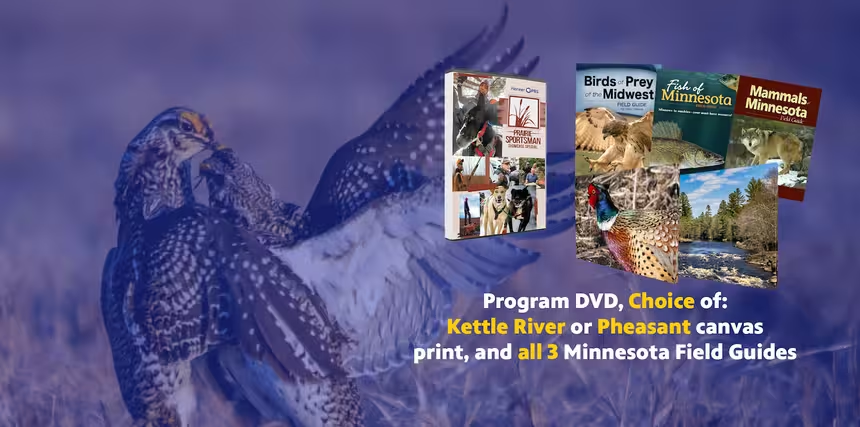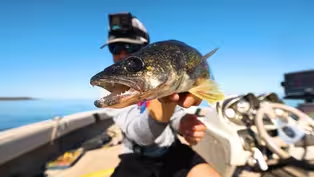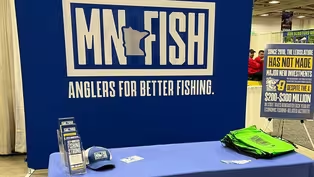Prairie Sportsman
Fast Forage: Honey Mushrooms
Clip: Season 15 Episode 13 | 4m 20sVideo has Closed Captions
Nicole Zempel forages for honey mushrooms.
Nicole Zempel forages for honey mushrooms that grow in clusters and can be identified by a distinctive ring on its stem.
Problems playing video? | Closed Captioning Feedback
Problems playing video? | Closed Captioning Feedback
Prairie Sportsman is a local public television program presented by Pioneer PBS
Production sponsorship is provided by funding from the Environment and Natural Resources Trust Fund, West Central Initiative, Shalom Hill Farm, and members of Pioneer PBS.
Prairie Sportsman
Fast Forage: Honey Mushrooms
Clip: Season 15 Episode 13 | 4m 20sVideo has Closed Captions
Nicole Zempel forages for honey mushrooms that grow in clusters and can be identified by a distinctive ring on its stem.
Problems playing video? | Closed Captioning Feedback
How to Watch Prairie Sportsman
Prairie Sportsman is available to stream on pbs.org and the free PBS App, available on iPhone, Apple TV, Android TV, Android smartphones, Amazon Fire TV, Amazon Fire Tablet, Roku, Samsung Smart TV, and Vizio.

Prairie Sportsman Premium Gifts
Do you love the great outdoors, hunting, fishing, hiking and conservation? Consider becoming a friend of Prairie Sportsman to support the show and receive gifts with your contribution.Providing Support for PBS.org
Learn Moreabout PBS online sponsorshipThat's so today we have had the pleasure of stumbling upon some what is commonly called honey mushrooms.
These mushrooms aren't typically a beginners mushroom, but I always kind of hate when people say that too, because we're all beginners at some point in time.
If you are thinking about consuming honey mushrooms and you think you might have identified a honey mushroom, do your due diligence, do a spore print and just really make sure, like, as you can see, they're growing next to other capital aid mushrooms here.
These obviously you can tell they're not the same mushroom, but sometimes there are mushrooms that look similar to a honey mushroom and especially after like a really good rain, cause then they get a little wealthy and their caps get a little waterlogged.
And so some of the iodine characteristics kind of all bleed into one.
So again, just do your due diligence.
Another thing with the honey mushroom is some people love them and some people love them but just can't tolerate them.
They can be a little hard on the digestive system for some folks giving them gastrointestinal upset.
So just always start with a tiny amount.
I'm really selling these honey mushrooms, aren't I?
But having said all of that, I am super excited because these are in my top five favorite mushrooms to consume.
There is of a good five or six different varieties of honey mushrooms that are edible are malaria, and then the second part of the scientific name, I would make up the different varieties of which we will post on the screen for you because I can not pronounce it.
So this particular honey mushroom, they do typically grow in clusters and so I'm holding them all together here.
But before I cut them, they were clustered together just like this.
And usually you're going to find honey mushrooms, as you can see.
Here they are conjoined at the base of their stems.
I am going to take them apart here so we can go over and you can see that they're still kind of cool.
Go in there, go over some of what you're going to be looking for.
So this little guy is a young one and you can tell here it's got like the little cobweb veil.
And as that cap grows and expands, that veil is going to break open.
But it's going to leave what's called a ring on the stem.
And so for larger honey mushrooms, one of the iodine characteristics is you will see that ring on the stem.
Now, here with the larger one, you can see that cobweb veil is starting to to to break open.
And then what you'll see there, some really pretty white gills.
And then also so when you do your due diligence to know what kind of a mushroom you have, you're going to take a spore print and the honey mushroom leaves like a white to a buff spore print.
And then I love how somebody described the Caps as kind of that 5:00 shadow.
There is just little I don't know if you want to call them hairs or fine little granular speckles, but the caps of honey mushrooms have those as well.
And then the honey mushroom is a really clean mushroom, usually not any bugs in there.
And to me, in my opinion, it more closely resembles like the button mushrooms that you can get from a grocery store as far as taste as well.
So the honey mushroom.
Preview: S15 Ep13 | 30s | Advocating for fishing in Minnesota and doctors prescribing outdoor therapy. (30s)
Video has Closed Captions
Clip: S15 Ep13 | 7m 7s | Doctors prescribe outdoor therapy to treat stress-related ailments. (7m 7s)
Video has Closed Captions
Clip: S15 Ep13 | 17m 39s | MN-FISH is fighting for fishing in Minnesota, including pushing for a new hatchery. (17m 39s)
Providing Support for PBS.org
Learn Moreabout PBS online sponsorshipSupport for PBS provided by:
Prairie Sportsman is a local public television program presented by Pioneer PBS
Production sponsorship is provided by funding from the Environment and Natural Resources Trust Fund, West Central Initiative, Shalom Hill Farm, and members of Pioneer PBS.
















